Discover the Weirdest Tourist Attractions in America
10 Mind-Bending Places That’ll Make You Question Reality (I Did)
Hey there, adventure seekers! Hutch here, and boy, do I have some weird tourist attractions in America to share with you. Forget about those typical tourist traps, I’m talking about spots that’ll make your brain do backflips and your Instagram followers (or book of Faces) do double-takes. If you’re fascinated by places that make you go “Wait, what?!”, Nevada is packed with offbeat attractions like the Clown Motel and the Extraterrestrial Highway, weird in all the right ways, then let discover some of the weirdest tourist attractions in America together.
1: The Wave, Arizona: Nature’s Acid Trip
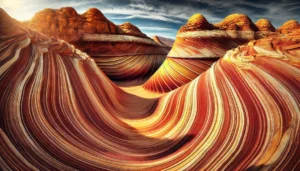
Picture this: I’m standing in the middle of what looks like a giant, frozen strawberry-vanilla swirl ice cream cone made of rock. That’s The Wave for you. Hidden in the Coyote Buttes North area of the Vermilion Cliffs National Monument, this mind-bending sandstone formation looks like Mother Nature went through her artistic phase.
Let me tell you about getting there, because this isn’t your typical “plug it into Google Maps and go” destination. First, you’ll need to win what I like to call the “hiking lottery.” No, really. The Bureau of Land Management only allows 64 people per day to visit (48 online permits and 16 walk-in permits), making this harder to get into than an exclusive nightclub in LA. I applied four times before scoring a permit, and I celebrated like I’d won an Oscar.
The adventure starts way before you see those famous swirls.
The trail? It’s a 6.4-mile round trip hike that’s about as well-marked as my career path after college. There are no real trails, just photo guides and GPS coordinates. I watched three different couples argue about directions, which was free entertainment but also a good reminder to triple-check my own navigation skills.
After what feels like a trek across Mars (minus the space suit), you’ll round a corner and BAM! The Wave hits you like a visual sugar rush. These sandstone formations, shaped by wind and water over 190 million years, create a twisted landscape of red, pink, yellow, and orange stripes that flow like fabric frozen in time. The patterns are so perfect they look Photoshopped in real life.
Here’s what I learned the hard way: this place is basically nature’s sauna. The temperature hit 100°F by 10 AM, and there’s zero shade unless you count your own shadow. I thought two water bottles would be enough, narrator voice: “They were not.” Pack water like you’re planning to share with every lizard in Arizona.
Pro Tips From Someone Who Did It Wrong First:
- Apply for permits 4 months ahead through recreation.gov
- Download offline maps because your phone signal will ghost you faster than a bad date
- Start hiking at sunrise, the light is better for photos and your survival odds
- Bring twice the water you think you need, then add another bottle
- Pack a wide-angle lens if you’re into photography (trust me, you’ll want it)
- Print the photo guide they send you with the permit, it’s your lifeline
Best Time to Visit: March to November offers the most stable weather, but October and November are prime time. The temperatures drop from “surface of the sun” to “pleasantly warm,” and the lighting is perfect for those Instagram-worthy shots.
Fun fact: The Wave’s patterns formed during the Jurassic Period, meaning dinosaurs probably walked on what would become this psychedelic landscape. I like to imagine T-Rex trying to take a selfie here.
2: Salvation Mountain, California: A Desert Rainbow Explosion

Remember those art projects you made as a kid with ALL the colors? Now imagine that on steroids, covering an entire hill. Leonard Knight spent decades creating this technicolor testament to love in the middle of nowhere, California.
I visited during summer (rookie mistake) and nearly melted, but the sight of this massive art piece rising from the desert like a tie-dyed mirage made the sweat worth it. The whole place looks like a Dr. Seuss book came to life. Think rivers of yellow paint flowing into seas of pink, with giant red hearts floating in an ocean of blue, it’s the kind of place that makes you question if someone slipped something into your morning coffee.
The mountain stands about three stories high and is completely covered in half a million gallons of donated paint. That’s right, this kaleidoscopic wonder was created entirely from paint that people just gave away. Talk about turning trash into treasure! The best part? Every inch tells a story, with Bible verses and messages of love woven into abstract shapes and patterns that’ll make your Instagram followers think you’ve discovered some secret psychedelic dimension.
Walking around the base, you’ll spot everything from painted trees that would make the Lorax jealous to intricate caves that feel like stepping into a rainbow’s living room. And don’t get me started on the yellow brick road, Dorothy would’ve taken one look and said, “Kansas who?”
Pro tip:
Visit in winter unless you want to experience what it feels like to be a popsicle in a microwave. And bring your camera, because trying to describe this place to your friends without pictures is like trying to explain what a sunset looks like to someone who’s only lived in a cave. Trust me, even your most outrageous photos won’t do it justice.
Oh, and wear shoes you don’t mind getting paint on, the desert dirt has a way of becoming a technicolor experience all its own. Consider it a free souvenir from one of the most wonderfully weird tourist attractions in America.
3: Carhenge, Nebraska: Stonehenge’s Automotive Cousin
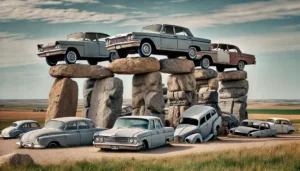
Who looks at Stonehenge and thinks, “You know what would make this better? Cars!” Apparently, someone in Nebraska did. This full-scale replica made entirely of vintage American cars painted gray is peak American weirdness, and I’m here for it.
I tried explaining this place to my mom: “It’s like Stonehenge, but with cars.” Her response: “Honey, are you feeling okay?” Yes, mom, just embracing the bizarre beauty of the American Midwest!
The mastermind behind this automotive druids’ dream was Jim Reinders, who apparently thought, “Ancient celestial calendar? Nah, let’s do that but make it Detroit.” Using 39 cars including a 1962 Cadillac and several Chevys from the ’50s and ’60s, he created this monument as a memorial to his father. Because nothing says “I love you, Dad” quite like balancing cars on their ends and painting them battleship gray.
The best part? Some of the cars are buried hood-first in the ground, standing up like giant metal tombstones in the Nebraska prairie. It’s the kind of place that makes you wonder if this is what aliens would build if they landed in America and only had access to a junkyard.
Walking around the circle of cars, you can’t help but appreciate the dedication it took to recreate the precise measurements of the original Stonehenge. Though I’m pretty sure the ancient Druids didn’t have to deal with removing transmissions or draining engine oil before hoisting their stones into place.
And let’s talk about the “Car Art Reserve” surrounding the main attraction, a collection of other automotive sculptures that look like they came straight out of a Mad Max movie directed by Salvador Dalí. There’s a station wagon that thinks it’s a fish, and a bunch of cars arranged in a formation that’s supposed to be a dinosaur (I think?).
Pro tip:
Sunset photos here look amazing. The long shadows of cars standing on end create some seriously cool effects. Plus, visiting at golden hour means you won’t melt in the Nebraska summer sun while pondering the deep philosophical question: “Is this what happens when cars go to heaven?”
Bonus tip: Check their event calendar, they sometimes host astronomy nights. Because the only thing cooler than cars pretending to be ancient stones is stargazing among cars pretending to be ancient stones.
4: Great Salt Lake’s Spiral Jetty, Utah: The Earth Art That Plays Hide and Seek
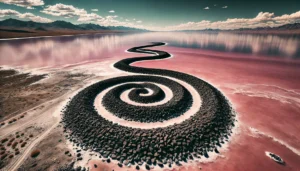
Robert Smithson’s Spiral Jetty is like that friend who sometimes ghosts you, some days it’s there, some days it’s underwater. This massive earthwork sculpture spirals into the Great Salt Lake like a giant’s signature.
When I visited, the lake was pink (yes, pink!) from algae, making the whole scene look like something from another planet. The crunch of salt crystals under my boots sounded like walking on frost, even in 90-degree weather.
Picture this:
6,650 tons of black basalt rocks and earth curling into the lake like nature’s biggest doodle. Smithson basically looked at a pristine shoreline and thought, “You know what this needs? A 1,500-foot long rock coil.” And somehow, he absolutely nailed it. It’s the kind of art that makes you feel like you’ve stumbled onto the construction site of ancient aliens with a flair for minimalist design.
The drive out there is an adventure in itself, think dirt roads that make your GPS have an existential crisis. Just when you’re convinced you’re hopelessly lost in the Utah desert (and questioning your life choices), boom! There it is… maybe. The jetty plays this fascinating game where it transforms completely based on the lake’s water levels and mineral content. Sometimes it’s a stark black spiral against white salt, sometimes it’s crusted in glittering crystals like nature’s bedazzling project, and sometimes it’s doing its best submarine impression under rosy waters.
I spent hours walking the spiral, each step taking me further into what feels like a meditation in motion. The whole thing is designed to be walked, like a labyrinth for the Instagram age. And speaking of photos, every angle gives you a different shot. The curve against the pink water, the mountains in the distance, the way the salt formations create these perfect geometric patterns, it’s like Mother Nature and modern art had a baby, and that baby is really into spirals.
Pro tip:
Check water levels before you drive all the way out there, unless you enjoy looking at underwater art (which, to be fair, is also pretty cool). And bring water, lots of it. The salt flat reflects sun like a giant mirror, and trust me, your body will remind you that you’re basically walking through nature’s biggest salt shaker.
Extra tip: Wear shoes you don’t mind sacrificing to the salt gods. Those crystals are beautiful but ruthless, they’ll turn your favorite boots into a science experiment about the corrosive properties of salt faster than you can say “environmental art.”
And one more thing: Time your visit for sunset if you can. When the light hits those salt crystals just right, the whole spiral looks like it’s made of diamonds. It’s the kind of view that makes you forget about your salt-crusted shoes and the fact that your car will never be the same after that dirt road adventure.
5: Winchester Mystery House, California: The House That Confusion Built

Sarah Winchester built this house nonstop for 38 years with one goal: to confuse ghosts. The result? A mansion that makes M.C. Escher’s drawings look straightforward. We’re talking stairs to nowhere, doors that open into walls, and windows in floors.
During my tour, I got lost three times… in the same hallway. How? I still don’t know. The guide said it was part of the experience, but I think she was just being nice.
Picture a house designed by someone playing The Sims while having a fever dream.
Sarah Winchester, heiress to the Winchester rifle fortune, kept construction going 24/7 for nearly four decades, supposedly on the advice of a medium who told her she’d die if the hammering ever stopped. Talk about extreme home renovation!
The numbers are as wild as the architecture: 160 rooms, 40 bedrooms, 13 bathrooms (but only one working shower, apparently ghosts aren’t big on personal hygiene), 47 fireplaces, and 2,000 doors. And get this, some doors open into brick walls, while others might drop you into a kitchen sink from a second-story height. It’s like a funhouse mirror maze had an identity crisis and decided to become a Victorian mansion instead.
The house is full of Sarah’s peculiar obsession with the number 13. Chandeliers with 13 lights, windows with 13 panes, stairways with 13 steps, even the sink drains have 13 holes. Though honestly, after wandering through this architectural Twilight Zone, I started seeing patterns everywhere. Was that wallpaper actually moving, or was it just my brain trying to make sense of a house that actively refuses to be logical?
My favorite part? The “séance room” where Sarah supposedly communicated with spirits every night to get the next day’s building plans. It has one entrance and three exits, because apparently even ghosts need multiple escape routes from awkward conversations.
Pro tip:
Take the night tour if you’re brave. It’s spookier, and somehow the architectural chaos makes more sense in the dark. Plus, getting lost in a dimly lit corridor that might lead to a) a beautiful Victorian parlor, b) a door six feet off the ground, or c) absolutely nowhere, adds that extra thrill of “am I actually in a real-life puzzle game?”
Fun fact: The house originally stood seven stories tall until the 1906 earthquake knocked it down to four. Legend has it that Sarah took this as a sign from the spirits that they were unhappy with the construction. Because when your house gets partially destroyed by an earthquake, the logical conclusion is clearly “the ghosts did it.”
Fair warning: If you’re someone who likes things to make sense, this place might give you a mild existential crisis. But if you can embrace the chaos and accept that sometimes a door should lead to a 20-foot drop just because, you’re in for a treat. Just remember, if you see a ghost, it’s probably just as lost as you are.
6: Biosphere 2, Arizona: Earth’s Backup Plan

Imagine a giant greenhouse that’s actually eight giant greenhouses pretending to be one greenhouse. That’s Biosphere 2. It’s like someone took a slice of Earth, shrink-wrapped it, and said, “Here’s our backup planet!”
Walking through different climate zones in minutes feels like cheating at travel. Desert to rainforest in 30 steps? Yes, please! Though I have to say, the “human habitat” section looks suspiciously like my first apartment.
Built in the late ’80s like some kind of ecological mullet (business on top, party ecosystem underneath), this 3.14-acre structure looks like what would happen if a Bond villain decided to go eco-friendly. It’s got its own ocean (complete with coral reef), rainforest, desert, and savannah, basically Earth’s greatest hits album under glass.
The place became famous in the ’90s when eight scientists sealed themselves inside for two years, living off only what they could grow and recycle. Think “Big Brother” meets “The Martian,” but with more oxygen drama and fewer potatoes. Turns out recreating Earth’s entire ecosystem is harder than it looks, who knew? The experiment had its ups and downs, including the time they had to secretly sneak in oxygen because, well, breathing is kind of important.
Today, it’s a research facility where scientists study everything from climate change to how plants might grow on Mars. The artificial ocean is the size of an Olympic pool, and yes, it makes waves, because apparently if you’re going to build a fake ocean in the desert, you might as well go all out. The rainforest section is so humid it actually rains inside (take that, indoor plumbing!).
The coolest part?
The “lungs” of the building, massive geodesic domes that expand and contract to handle air pressure changes. Without them, the structure would either explode or implode from temperature fluctuations. It’s like giving a building Spanx, but for survival.
Pro tip:
The guided tour is worth it. Otherwise, you’ll spend the whole time wondering why anyone would build this massive glass terrarium in the middle of the desert. Plus, the guides tell the best stories about the original “biospherians”, like how they lost so much weight they started eating the emergency food supplies meant for their pet chickens (don’t worry, the chickens were fine).
Bonus tip: Visit on a hot day and you’ll gain a whole new appreciation for air conditioning. Nothing makes you value modern climate control quite like walking through a tropical rainforest that’s INSIDE a greenhouse that’s INSIDE the Arizona desert. It’s like inception, but with sweat.
And here’s a fun fact they don’t put in the brochure: Biosphere 2 is called “2” because Biosphere 1 is… Earth. Which means technically, we’re all living in the beta version. Let that sink in while you’re watching scientists play God with their miniature world-in-a-bottle.
Just remember to bring water, you might be indoors, but you’re still in the desert. And yes, that means you can potentially get dehydrated while standing next to an artificial ocean. If that’s not peak human achievement, I don’t know what is.
7: The Mystery Spot, Santa Cruz: Where Physics Goes on Vacation

You know those days when nothing makes sense? The Mystery Spot is like that, but on purpose. This California roadside attraction claims to defy gravity, and after visiting, I’m not entirely sure it doesn’t.
8:Thor’s Well, Oregon: Neptune’s Angry Drain
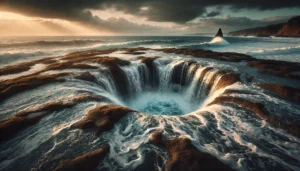
Imagine the ocean having a sink drain. That’s Thor’s Well. This natural sinkhole off the Oregon coast looks like it’s draining the Pacific Ocean. The first time I saw it, I half expected a giant sea monster to emerge.
Standing there watching the waves crash and swirl into what looks like a bottomless pit really puts things in perspective. Like, maybe my problems aren’t so big compared to nature’s power moves.
Also known as Spouting Horn, this coastal phenomenon is what happens when Mother Nature decides to flex on Instagram. It’s a roughly 20-foot deep sinkhole that fills up with the ocean and then drains away in a mesmerizing (and mildly terrifying) display of hydraulic drama. Think of it as nature’s version of a magic trick, now you see the water, now you don’t, now you’re wondering if you’re watching the apocalypse begin.
The show gets really good about an hour before high tide, when the Pacific decides it’s time for its daily performance art piece. Waves surge into the hole like they’re auditioning for a disaster movie, creating a roiling cauldron of foam and spray that would make any special effects artist jealous. Then the water drains away with a gurgling rush that sounds suspiciously like the Earth clearing its throat.
The whole spectacle is set against a backdrop of jagged volcanic rock in Cape Perpetua Scenic Area, making it look like something straight out of Norse mythology (hence the name). The surrounding area is a maze of tide pools and blowholes that remind you that the Oregon coast isn’t just pretty, it’s pretty mental.
Pro tip:
Stay back from the edge! Those “just a little closer” photos aren’t worth becoming part of the ocean’s recycling system. Seriously, this isn’t a water park feature, it’s a powerful gateway to the Pacific that has no interest in your social media clout.
Advanced tip:
Visit during winter storms for maximum drama, but only if you enjoy being blasted with sea spray and questioning your life choices. The waves can reach heights of 20 feet or more, turning Thor’s Well into nature’s version of a pressure washer.
Time your visit around high tide, but don’t forget to check weather conditions. The best photos happen when the sun is lower in the sky and the waves are angry enough to be impressive but not so angry they’re actively trying to relocate you to Hawaii.
And a word about footwear: those slippery rocks are not your friends. Wear shoes with good grip, because nothing ruins a dramatic nature photo quite like an unexpected pratfall into a tide pool. The algae-covered rocks are basically nature’s Slip ‘N Slide, except instead of a gentle glide to a stop, you get a free trip to the emergency room.
Remember: Thor’s Well may look like the world’s most impressive drain, but it’s really more like nature’s way of reminding us that we’re just visitors here. And sometimes the best way to appreciate nature’s power is from a respectful distance, preferably one that doesn’t require a Coast Guard rescue team.
9: House on the Rock, Wisconsin: The Ultimate Hoarder’s Paradise
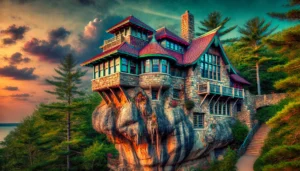
If your eccentric uncle collected everything he saw for 50 years, threw it all in a house built on a rock, and then added the world’s largest carousel just for fun, you’d have the House on the Rock. This place makes your weird antique-collecting neighbor look like a minimalist.
I spent four hours here and saw maybe half of it. The carousel alone has 269 creatures, none of which are horses. Because why be normal when you can have a carousel with giant sea monsters?
Created by Alex Jordan Jr., a man who apparently never met a collectible he didn’t like, this place is what happens when “maybe I’ll buy it” becomes a life philosophy. The house itself starts reasonably enough, perched on a 60-foot chimney of rock, offering stunning views of Wyoming Valley. But then you step inside, and reality takes a sharp left turn into Wonderland.
Imagine walking through rooms where automated orchestras play themselves (slightly out of tune, because creepy is apparently the aesthetic), past walls covered in weapons that would make a medieval army jealous, and into a room with a 200-foot-tall sea battle diorama. Yes, you read that right. And that’s just the warm-up act.
The Infinity Room:
Is a glass-walled needle that stretches 218 feet out over the valley without support, which is both an architectural marvel and a test of your trust in Wisconsin building codes. But the real mind-bender? The “Streets of Yesterday”, an indoor Victorian town that makes Disney’s Main Street look understated. It’s got fully stocked shops, automated fortune tellers, and enough dolls to fuel a lifetime of nightmares.
And then there’s that carousel. The world’s largest indoor carousel, spinning in perpetual motion, never giving rides, lit by 20,000 lights, surrounded by angels hanging from the ceiling (because why not?). It’s like someone designed a merry-go-round after eating too many cheese curds before bed. Not a single horse in sight, but want to ride a giant peacock next to a fire-breathing dragon? Step right up!
Pro tip:
Don’t try to see it all in one day. Your brain will thank you for spreading out the weirdness. Also, bring water, getting lost in the world’s largest collection of… everything… is thirsty work.
Navigation tip:
The place is divided into three sections, and yes, you’ll need a map. Without it, you might wander into the doll room and never be seen again. Speaking of which, if dolls creep you out, there are some sections you might want to speed-walk through. Just saying.
Fun fact: No one knows exactly how many items are in the collection because apparently cataloging “everything ever made” is challenging. Even the staff discovers new items tucked away in corners. It’s like a Where’s Waldo book came to life and ate a museum.
And here’s the kicker, half the stuff might be fake. Jordan was notorious for making up elaborate backstories for his collections. But at some point, you stop caring what’s real and what isn’t because you’re too busy staring at a three-story-tall whale battling a giant octopus while a self-playing orchestra provides the soundtrack.
Remember: Just when you think it can’t get any weirder, it does. That room full of vintage cars? Keep walking. The collection of massive music machines? There’s more. The Japanese garden? Just wait until you see what’s next. It’s like being inside the imagination of someone who couldn’t decide what to collect, so they just said “yes” to everything.
10: Coral Castle, Florida: One Man’s Rocky Romance
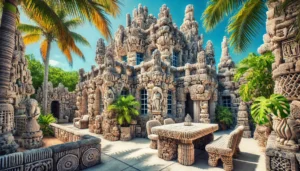
Ed Leedskalnin spent 28 years building this limestone monument, supposedly because his fiancée canceled their wedding. Talk about a breakup project! The mystery isn’t just why he built it, but how, these stones weigh tons, and Ed was a tiny guy working alone at night.
The place is full of perfect astronomical alignments and engineering mysteries. My favorite part? The 9-ton gate that moves with a finger’s push. Mine got stuck once, but that might be because I tried to open it while saying “Open Sesame.”
Built between 1923 and 1951, this is what happens when someone takes “if you love something, set it in stone” way too literally. Ed, all 5 feet and 100 pounds of him, somehow managed to quarry, transport, and perfectly position over 1,100 tons of coral rock. For perspective, that’s like moving about 100 elephants worth of stone. By yourself. At night. With hand tools. Because apparently, that’s what heartbreak does to some people.
The whole place is like a Stone Age theme park designed by a lovestruck genius.
There’s a 25-ton telescope that perfectly aligns with the North Star (star-crossed lovers, anyone?), rocking chairs made entirely of limestone (comfort wasn’t high on Ed’s priority list), and a Fountain of Youth that probably won’t actually keep you young but will definitely make you appreciate modern plumbing.
The engineering is mind-boggling.
That famous gate? It’s so perfectly balanced that it used to move with just the touch of a finger, thanks to a mysterious mechanism that had engineers scratching their heads for decades. When it broke in 1986, it took six men and a 20-ton crane to fix what Ed built alone. And they still couldn’t get it quite as smooth as the original.
Every piece has a story. There’s the “Florida Table” shaped like the state (because when you’re already hauling multi-ton rocks around, why not get artistic?), a heart-shaped table (subtle, Ed), and beds, yes, stone beds. Including a children’s bed, which makes you wonder if Ed was maybe getting a bit ahead of himself with the whole reconciliation plan.
Pro tip:
Visit during the cooler months. Florida summer heat plus limestone reflection equals human pizza oven. Also, those stone chairs? Bring a cushion unless you want to experience what sitting on ancient monuments actually feels like.
Science tip:
Try bringing a compass. The whole structure is supposedly built along magnetic lines, and weird things happen to electromagnetic equipment. Your phone might go wonky, but that could just be Florida being Florida.
Ed claimed he knew the secrets of the pyramids and had “discovered the laws of weight and leverage.” He would only work at night, and if anyone tried to watch him, he’d stop until they left. Some say he used supernatural powers, others think he was a secret engineering genius. All we know for sure is that he wrote a pamphlet called “A Book in Every Home” that’s part construction theory, part relationship advice, and entirely confusing.
The castle’s most impressive feature might be its price tag, Ed charged ten cents for tours, living proof that romance isn’t dead, it just has really weird pricing strategies. Today, it’s a bit more expensive (less than $20), but still cheaper than therapy or building your own megalithic monument to lost love.
And here’s the ultimate irony, this monument to lost love has hosted countless weddings over the years. Somewhere, Ed is either smiling or rolling his eyes. Or both. Probably both.
Final Thoughts
These places remind me why I love exploring the weird side of America. Sure, you could stick to regular tourist spots, but where’s the fun in that? These destinations prove that sometimes the best travel stories come from places that make you ask, “Why does this exist?”
Each spot on this list has left me with questions, laughs, and some seriously strange photos. They might not all make sense, but they’ll definitely make memories. And isn’t that what travel is all about?
So pack your sense of wonder (and maybe a level for The Mystery Spot), and get out there! Just remember: the weird side of America is best explored with an open mind and a good camera. You’re going to want proof when you tell these stories later, trust me, no one believes the “water flowing uphill” story without video evidence.
Got any weird spots to add to the list? Drop them in the comments! I’m always looking for more places that make me question reality.
See y’all out there somewhere, or will I???. Be safe and have fun.
I don’t think the title of your article matches the content lol. Just kidding, mainly because I had some doubts after reading the article.
Hey there, thanks for the comment, and for giving me a chuckle with that title jab! 😄 I truly appreciate you taking the time to read the post. The goal of this blog is to share real, useful travel advice, especially the kind that holds up when you’re actually out there doing it, and to toss in a few ideas and personal thoughts along the way.
If you or anyone ever spots something that seems off or could use clarification, I’d genuinely welcome your input in the comments. I want this to be a helpful space for travelers of all kinds, and feedback like yours is what keeps it sharp.
Thanks again for dropping by!
Your article helped me a lot, is there any more related content? Thanks!
Thanks for sharing. I read many of your blog posts, cool, your blog is very good.